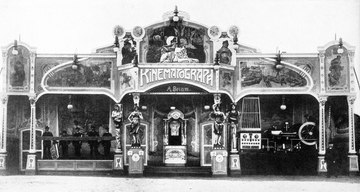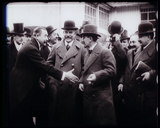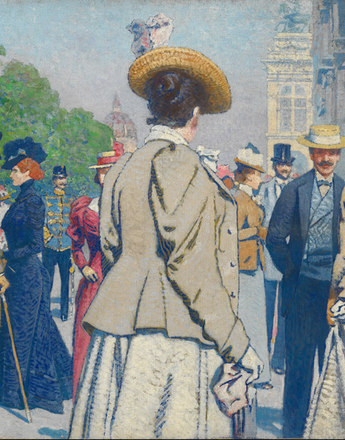From travelling show to cinema

Travelling cinema, photograph, 1904
Copyright: Filmarchiv Austria
Partner: Filmarchiv Austria
-

Travelling cinema tent in the Film Archive garden in Vienna, photograph
Copyright: Filmarchiv Austria
Partner: Filmarchiv Austria -

The cinema exhibition, film still, A/F 1912
Copyright: Filmarchiv Austria
Partner: Filmarchiv Austria -

Advertisement for the Zentraltheater für Kinematographie, 1913
Copyright: Filmarchiv Austria
Partner: Filmarchiv Austria
Even before the turn of the century, vaudeville theatres were the main venue for film projections in Austria-Hungary, and travelling shows remained popular until 1910. Because there were so few films, the main programme needed to have variety, and the shows also had to move around rapidly to different places.
The shows would be set up at busy sites such as railway stations, factories or fairs. The operators attempted to attract potential customers by all conceivable means. The colourful wagon was the first eye-catcher. The illuminated facades of the mobile cinemas lit up in the darkness of night. Barkers announced the visual sensations and fascinating programme awaiting the spectators. As there were few copies of the films, the repertoire was limited, and public interest in the cinematographic shows, which often lasted only 10 to 15 minutes – particularly in smaller towns – waned very quickly. Most of the moving pictures were made by small-time producers in limited quantities for their own use. There was no highly developed distribution system, and the films were purchased directly from the producer or exchanged between the travelling showmen. The first professional film distribution organization in the Monarchy was established in 1905 in Vienna.
By 1910 the film sector had started to become industrialized. The mass-produced and increasingly sophisticated films needed to be distributed quickly and shown at fixed and reliable sites. The elaborate accompaniment to the film presentation became obsolete as the content of longer, more detailed and expensively produced films sold itself. A star system developed at the same time, and the performers became attractions in their own right. Film projections thus moved away from travelling shows to permanent establishments. The first cinemas in Vienna were built between 1903 and 1905, and the Imperial Association of Cinematograph Owners was founded in 1908. The travelling showmen were clearly underrepresented in it, and the cinema owners were also increasingly unappreciative of their showmen colleagues. They were at pains to raise the status of their metier by distancing themselves from fairground attractions and identifying themselves more with the high art of the theatre. By 1909 there were already sixty-two cinemas in Vienna compared with fourteen travelling shows, and in 1913 there were 400 cinematographic operations in the Habsburg Monarchy, of which 200 were travelling shows. By this time there were 130 permanent cinemas in Vienna.
Translation: Nick Somers
Kieninger, Ernst: Das „klassische Wanderkino“ 1896–1914. Filmkommunikation auf dem Weg zur Institution am Beispiel Niederösterreich und Umland, Diplomarbeit, Wien 1992
Schwarz, Werner Michael: Kino und Kinos in Wien. Eine Entwicklungsgeschichte bis 1934, Wien 1992
-
Chapters
- Projection shows – precursors of the cinema
- The first cinematograph in Vienna – a medium takes Austria-Hungary by storm
- From travelling show to cinema
- Roll up! Performances, attractions, shows and sound experiences
- ‘Numbers’ – jewels from all over the world
- From ‘view’ to narration: genres and stars
- Austrian film pioneers


